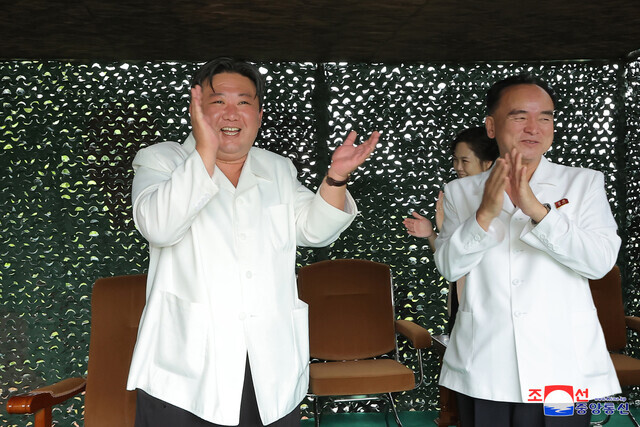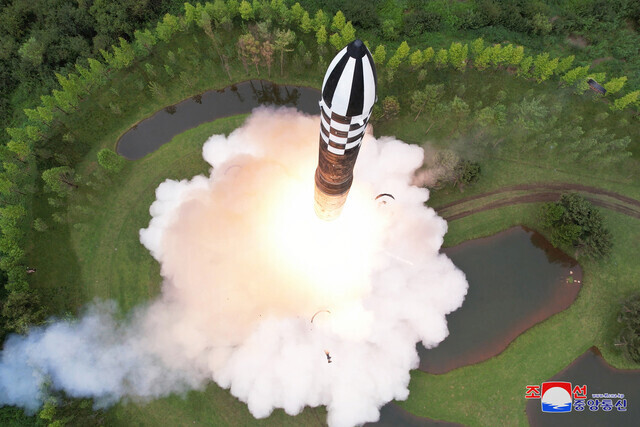hankyoreh
Links to other country sites 다른 나라 사이트 링크
Rapid advancement in N. Korea’s solid-fuel ICBM tech ratchets up tenor of threat

North Korea officially announced Thursday that the missile it fired into waters off its eastern coast the previous day was the Hwasong-18, a new intercontinental ballistic missile (ICBM) that uses a solid-fuel propulsion system.
“A series of stronger military [offensives] will be launched until the US imperialists and the South Korean puppet traitors [give up] their useless hostile policy toward the DPRK,” North Korean leader Kim Jong-un was quoted as saying while personally supervising the missile’s test launch.
DPRK is an acronym for North Korea’s official name.
The Hwasong-18’s second test launch on Wednesday appears to reveal a huge step forward in engine propulsion from the first test launch in April, suggesting that North Korea is boosting its missile technology and the threat it poses to South Korea and the US.
South Korea and the US responded by holding joint air exercises on the Korean Peninsula with a visiting contingent of American B-52H strategic bombers, which are capable of carrying nuclear weapons.
“The test-fire was conducted according to the strategic judgment and crucial decision of the Central Military Commission of the Workers’ Party of Korea (WPK) [. . .] as a part of the efforts to bolster the just right to self-defence,” reported the Rodong Sinmun, North Korea’s state-run newspaper, in regard to North Korea’s first ICBM launch in 90 days.
The newspaper said the test was also designed “to clearly make the enemies realize the danger and recklessness of their anti-DPRK military option.”
Given the trends on the Korean Peninsula, the article strongly implies that Kim Jong-un personally chose the timing of the test launch. The launch came immediately after two statements on Monday and Tuesday in which his sister Kim Yo-jong, whose official title is vice department director of the Central Committee of the Workers’ Party, warned about a military response to the US’ aerial reconnaissance activities. The launch also coincided with a meeting of South Korea’s, the US’ and Japan’s joint chiefs of staffs and a meeting of leaders at the NATO summit, which was also attended by South Korean President Yoon Suk-yeol.
There are concerns that the rising tensions on the Korean Peninsula in the weeks leading up to the anniversary of the Korean War armistice on July 27 (which is celebrated in North Korea as the Day of Victory in the Great Fatherland Liberation War) bring with them a nonzero risk of an unintended military clash.
In its article about the launch, the Rodong Sinmun described “the military security situation on the Korean Peninsula and in the region” as being a “phase of nuclear crisis” even worse than the Cold War era. The newspaper took particular umbrage with two American practices; namely, that it has been “dispatching nuclear-powered [submarines] and nuclear strategic [bombers] to the Korean Peninsula and its vicinity” and “planning to reintroduce nuclear weapons [to] the Korean Peninsula by sending a US nuclear submarine carrying strategic nukes to South Korea for the first time in 40 years.”
Such moves, the newspaper contended, amount to “provocative [acts] of aggressiveness” in all particulars.
The Rodong Sinmun also served up criticism of the Washington Declaration, released on April 26, in which the leaders of South Korea and the US agreed to operate a Nuclear Consultative Group in response to the North Korean nuclear threat. The Workers’ Party mouthpiece bashed the Washington Declaration as being “a program for nuclear confrontation with the DPRK” and accused the US of “openly planning to discuss the use of nuclear weapons against our state.”
North Korea responded testily to the Washington Declaration, which stipulates the ongoing deployment of US strategic assets on the Korean Peninsula.
The Nuclear Consultative Group’s first meeting is scheduled to be held in Seoul on July 18. In addition, Brig. Gen. John Weidner, the chief of staff of US Forces Korea, said Monday that a SSBN — a nuclear-powered submarine equipped with nuclear-tipped ballistic missiles — will soon be deployed to South Korea.

This was the second test launch of the Hwasong-18, North Korea’s first solid-fuel ICBM. The first test was carried out on April 13 with on-the-spot guidance by Kim Jong-un.
“The missile traveled up to a maximum altitude of 6,648.4 km and flew a distance of 1,001.2 km for 4,491s [1 hour, 14 minutes, and 51 seconds] before accurately landing on the preset area in the open waters off the East Sea of Korea,” the newspaper said of the Wednesday launch.
The newspaper explained that the missile’s first stage was set in “standard ballistic flight mode” and the second and third stages in “high-angle flight mode,” adding that “the test-fire had no negative effect on the security of the neighboring countries.”
The missile’s “maximum altitude of 6,648.4 km” was more than twice as high as during the first test launch in April, as well as being the highest of any ICBM that North Korea has launched until now. Experts estimate that if the missile were launched at a standard angle (30-45 degrees) instead of a high angle, it could travel 15,000 km, enough to hit any spot in the continental US.
Kim Jong-un instructed the Workers’ Party of Korea in its eighth Congress in January 2021 to “set a goal of attaining an advanced capability for making a preemptive and retaliatory nuclear strike by further raising the rate of precision good enough to strike and annihilate any strategic targets within a range of 15,000 kilometres with pinpoint accuracy.”
“We will achieve ‘peace through strength’ based on the overwhelming military might of the ROK-US alliance,” said Lee Sung-jun, head of public affairs for South Korea’s Joint Chiefs of Staff, in the daily press conference Thursday, reiterating Seoul’s intention to stand up to Pyongyang.
The Joint Chiefs of Staff said later that evening that South Korea and the US had “carried out joint air exercises with B-52H strategic bombers from the US Air Force that are currently dispatched to the Korean Peninsula.”
In the air exercises, South Korean F-15K fighters and American F-16 fighters flew in formation in the skies above the Korean Peninsula in the company of the B-52H bombers, which returned to Korean skies just 13 days after their previous visit, on June 30.
As the situation on the Korean Peninsula deteriorates, there are growing concerns about the lack of any obvious safety valves or neutral mediators to mitigate the increasing risk of an unintended clash. That’s because the deterioration of inter-Korean relations is coinciding with the US’ ongoing conflicts with China and with Russia.
“The current situation, which resembles a game of chicken, could lead to an accidental military conflict that nobody intended. This is a moment when restraint is urgently demanded,” said an expert who held a senior position in a former Korean administration.
By Lee Je-hun, senior staff writer
Please direct questions or comments to [english@hani.co.kr]

Editorial・opinion
![[Column] Tariffs on China: Trump was dumb, Biden dumber [Column] Tariffs on China: Trump was dumb, Biden dumber](https://flexible.img.hani.co.kr/flexible/normal/500/300/imgdb/original/2024/0520/191716191153918.jpg) [Column] Tariffs on China: Trump was dumb, Biden dumber
[Column] Tariffs on China: Trump was dumb, Biden dumber![[Column] What if Seoul took reunification by force off the table? [Column] What if Seoul took reunification by force off the table?](https://flexible.img.hani.co.kr/flexible/normal/500/300/imgdb/original/2024/0520/3017161928630494.jpg) [Column] What if Seoul took reunification by force off the table?
[Column] What if Seoul took reunification by force off the table?- [Editorial] Intensifying US-China rivalry means Seoul must address uncertainty with Beijing sooner than later
- [Column] When ‘fairness’ means hate and violence
- [Editorial] Yoon must stop abusing authority to shield himself from investigation
- [Column] US troop withdrawal from Korea could be the Acheson Line all over
- [Column] How to win back readers who’ve turned to YouTube for news
- [Column] Welcome to the president’s pity party
- [Editorial] Korea must respond firmly to Japan’s attempt to usurp Line
- [Editorial] Transfers of prosecutors investigating Korea’s first lady send chilling message
Most viewed articles
- 1Xi, Putin ‘oppose acts of military intimidation’ against N. Korea by US in joint statement
- 2Kim Jong-un wanted to meet with residents of shelled Yeonpyeong Island in South, Moon recalls in mem
- 3To weigh costs and benefits, Korea must stop treating US troop presence as a sacred cow
- 4[Column] What if Seoul took reunification by force off the table?
- 5[Column] Tariffs on China: Trump was dumb, Biden dumber
- 6[Editorial] Transfers of prosecutors investigating Korea’s first lady send chilling message
- 7Berlin mayor hints at tearing down ‘comfort women’ memorial in city
- 8[Column] US troop withdrawal from Korea could be the Acheson Line all over
- 9[Editorial] Intensifying US-China rivalry means Seoul must address uncertainty with Beijing sooner t
- 10[Exclusive] Truth commission to seek additional murder charges for figures behind 1980 Gwangju massa